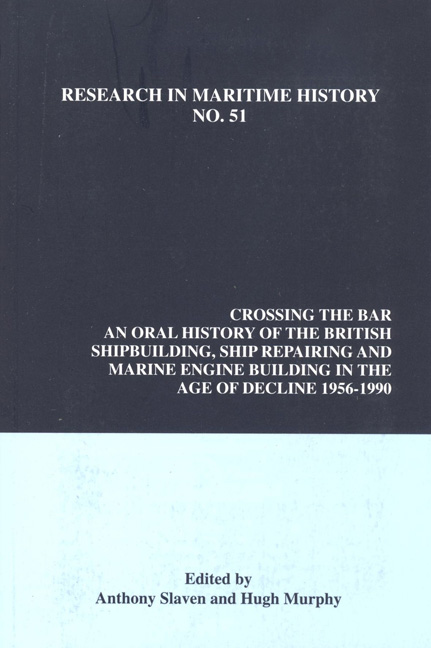 Crossing the Bar
Crossing the Bar Book contents
- Frontmatter
- Contents
- About the Authors
- Dedication
- Preface: A Shipbuilding Libretto
- Introduction
- Interviews
- Lower Clyde
- Upper Clyde
- The Tyne
- The Wear
- Barrow-in-Furness
- 26 Bill Richardson, Vickers Armstrong, Swan Hunter, British Shipbuilders Pic
- 27 Roy Turner, Vickers
- The South Coast
- The Humber
- Belfast
- British Shipbuilding Industry Officials
- The Trade Unions
- The Civil Servants, Board of Trade, Shipbuilding Enquiry Committee, Shipbuilding Industry Board, Ministry of Technology, Department of Trade and Industry, Department of Industry
- The Politicians
- Interviews British Shipbuilders Plc
- Conclusion
- Select Bibliography
27 - Roy Turner, Vickers
from Barrow-in-Furness
- Frontmatter
- Contents
- About the Authors
- Dedication
- Preface: A Shipbuilding Libretto
- Introduction
- Interviews
- Lower Clyde
- Upper Clyde
- The Tyne
- The Wear
- Barrow-in-Furness
- 26 Bill Richardson, Vickers Armstrong, Swan Hunter, British Shipbuilders Pic
- 27 Roy Turner, Vickers
- The South Coast
- The Humber
- Belfast
- British Shipbuilding Industry Officials
- The Trade Unions
- The Civil Servants, Board of Trade, Shipbuilding Enquiry Committee, Shipbuilding Industry Board, Ministry of Technology, Department of Trade and Industry, Department of Industry
- The Politicians
- Interviews British Shipbuilders Plc
- Conclusion
- Select Bibliography
Summary
I joined Vickers at Barrow as an apprentice ship draughtsman, and after two years won a Vickers Armstrong Scholarship. I entered Glasgow University in the late autumn of 1944, and graduated in naval architecture in 1947, and returned to Barrow. In 1949, I was appointed as an Assistant Ship Manager, and in 1950, I was put in charge of repairs, and in the following year I was appointed Assistant in the naval architects department. In April 1957, I was appointed as the Naval Architect to the Company, directly responsible to the Managing Director or Chairman for the overall naval architecture design aspects of all the ships built at the company's two shipyards, the Naval Construction Works, as it was called at Barrow, and the Naval Yard at High Walker on Tyne, a position I held virtually until I retired in 1989.
In the early days the company was run by people who, understanding the nature of the shipbuilding business, knew that there were two people who could get the Board the sack through losses and disasters. One was the chief estimator and the other was the naval architect. Both George Holden and Len Redshaw who were my successive bosses insisted on having a direct line to me. This was an arrangement that was very rare in British shipbuilding. In my view, a lack of similar understanding of the nature of the business led to many of the subsequent technical and financial disasters in the industry.
The first thing about Vickers was that it was a member of a group of companies with initially somewhere in the region of 150,000 employees. It had access to expertise, and, above all, to finance, which was denied to any of the individual companies [in the industry]. The most significant example of that financial benefit was the £19 million [this is a grossly inflated figure, whichdoes not accord with the facts, up to January 1947, Vickers did spend £2.25million] investment made in the period 1946 to 1950 in the new assembly shop and the four berths of the shipyard.
The next advantage was that Vickers at Barrow and on the Tyne had large drawing offices of very competent people. In Barrow, there was, initially, an integrated management of shipbuilders and engineers.
- Type
- Chapter
- Information
- Crossing the BarAn Oral History of the British Shipbuilding, Ship Repairing and Marine Engine-Building Industries in the Age of Decline, 1956-1990, pp. 112 - 118Publisher: Liverpool University PressPrint publication year: 2013


